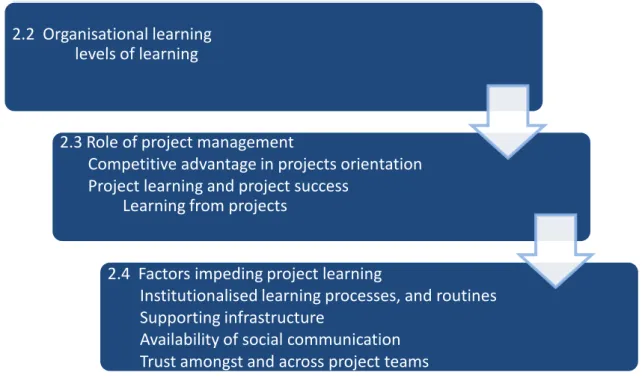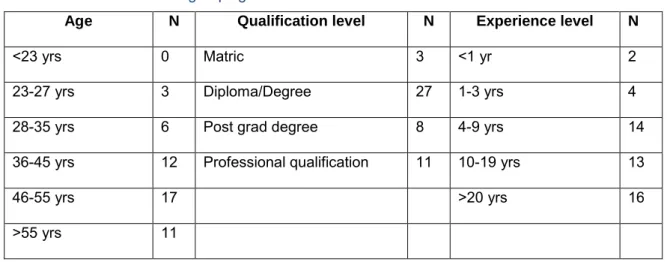I further declare that I have obtained the necessary authorization and consent to conduct this research. Pete Janse van Vuuren to my study supervisors for their guidance, motivation and advice in completing this research project;.
INTRODUCTION TO RESEARCH PROBLEM
Background
- Role and implications of project management to organisations
- Improving organisational performance using PM
They concluded that the main cause of these errors can be attributed to a general lack of communication of the extent of uncertainty and complexity of the project within the project teams, or an inability to adapt the management style to the specific situation. Despite the uniqueness of the project, lessons learned from one project can be applied to future projects, providing valuable lessons.
Research Problem
Experience shows that it is people who deliver successful projects, not methods and tools, and it is the ability of people to engage intelligently with the complexity of projects that is central to successful project management (Winter, M., Smith, C ., Morris, P & Cicmil, S., 2006).
Motivation for the Research
Research Objective
Thus, by eliminating barriers to intra- and cross-project learning, organizations can increase the successes of their projects. Recommendations on how to overcome identified barriers in order to leverage future project successes from previous project experiences.
Relevance of study in South Africa
Identifying the factors that influence the sharing of project knowledge within the project, as well as in other projects in the organization and between organizations. What prevents free communication and sharing?).
Introduction
Organisational learning
Role of project management
- Projects orientation
- Project success
- Learning from projects
Factors impeding project learning
- Inherent obstacles posed by institutionalised learning procedures
- Role of communication in learning and knowledge sharing
- Trust amongst teams and across project teams
- Supporting infrastructure for organisational learning
Research by Julian (2008) showed a network of strong relationships as an enabler of cross-project learning. Intra-project and inter-project learning in a project-oriented organization is less likely to succeed if there is a lack of learning-supporting and facilitating infrastructure in the organizations.
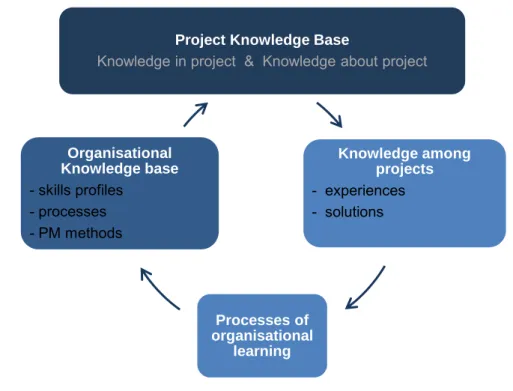
Introduction
Research approach
- Empirical /Non-empirical research
- Quantitative/Qualitative research
- Deductive/Inductive research
- Subjective/Objective research
An objective approach refers to the extent to which the researcher distanced himself from the empirical work. In this research, an objective approach was adopted in accordance with the research objectives and the quantitative approach.
Research design
Therefore, a more formalized, quantitative descriptive design was appropriate to the purpose and scope of the study. The study used an empirical approach, supported by the non-empirical data obtained from a literature search.
Population and sampling
Data collection, data analysis and data management
- Data Collection
- Survey Questionnaire
- Data analysis
- Data Validity
The last group (or Q31) aimed at obtaining a ranking or measure of perceived importance of each of the factors being researched. The last question, (Q31) aimed to establish participants' perceptions of the relative importance of the various factors that can or cannot learn. The assessment scores obtained from the four categories of results (f1 to f4) were used to determine how the measured impact of the proposed barriers correlates with the measured perceived project learning success.
Due to the quantitative nature of the study, it was prone to biases typical of a quantitative research.
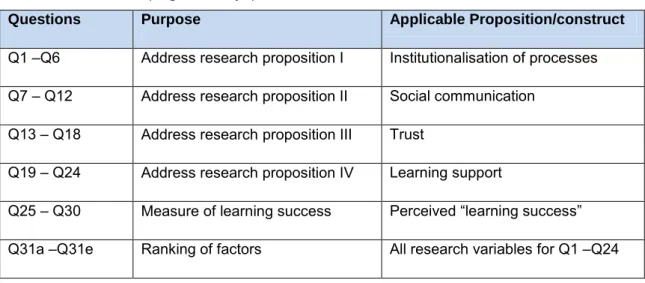
Research Limitations
Summary
Introduction
Review of Company Secondary Data
Further evidence of organizational learning programs includes an outsourced mentoring program for young engineers and an "engineering forum" based on the company's intranet. All engineers and project team members have access to the engineering forum to share and exchange any technical or interesting subject-relevant information.
Sample for Survey
- Sample Description
- Responses
- Response Bias Errors
- Questionnaire and Coding Scheme
The survey was open for participation for a period of two weeks subject to acceptable response rates. To improve the response rate, reminders were posted one week after the launch of the survey. Social desirability bias is also expected given the top-down distribution of the survey.
Respondents, especially the international component, were aware that the survey was issued from (and probably supported by) global headquarters and they were likely to provide answers that protected their business unit or their own position.
Analysis
- Demographics of respondents
- Reliability checks
- Means for data groups
- Correlation Tests
- Differences between Independent Groups
- Frequencies
For a data set, the mean is the sum of the values divided by the number of values. ANOVA compares group means to test for significant differences between the means of different groups. Age N Qualification level N Experience level N Comparison of the means for the respective modified demographic groups in terms of variable groups f1 to f5 revealed low levels of variance with the exception of "country".
In comparison, there are little differences between the means for any of the other groups (age, experience level, skill level) with respect to groups f1 to f5).

Introduction
Demographic correlates of the outcomes were limited to the results for location age and experience responses. The results were measured in relation to the location of the respondents, as a cultural influence on how actions are performed was expected. Another aspect that the researcher considered sufficiently important for correlation testing was the level of experience of the individual respondent.
The relationship between responses and characteristics related to respondents' age and education level was therefore not considered to be sufficiently relevant to perform similar correlations.
Respondent response rate
Unfortunately, the response rates from different locations were too low to draw significant conclusions from country to country, and the research rather focused on comparisons between two groups, the South African respondents and the international respondents. Different approaches and opinions were expected from more experienced respondents, as they might have developed or adapted their own personal ways and means of dealing with learning events or opportunities.
Reliability of Groups f1 to f5
Demographics
In comparison, there is little difference between the means of any other demographic group (age, experience level, qualification level) across all groups (f1 to f5). This means that the age, experience and level of qualifications of the respondents did not influence their answers to any of the questions asked. Since only those responses are related to the impact of social communication and trust, culture seems to have a clear impact on project members.
This is important as it adds another dimension to the notions of improved social communication and environment of trust.
Discussion of Research Questions
- Research Question 1
- Analysis
- Conclusion
Questions in group f5 measure respondents' perceptions of the success of project learning within their organization. From the mean value of 3.88 for Q31a, it is concluded that the institutionalization of project learning procedures and routines is perceived as an important learning opportunity. Since the majority of respondents are of the opinion that project learning is successful within their respective organizations, it can be argued that given the above, the lack of institutionalization of project learning procedures and routines is indeed seen as a barrier for project-based learning.
This means that well-institutionalized procedures and routines for capturing and sharing knowledge can be an important factor in successful project-based learning and a clear way to create a competitive advantage.
Research Question 2
- Introduction
- Analysis
- Conclusion
The mean value for questions in group f5, which measures the respondents' perception of the success of project learning in their own organization, is equal to 2.57. This perception in the context of the pro-social communication perceptions inferred from the mean value of 2.88 for Q31b, it is inferred that social communication/interaction is perceived as less important than other factors as an enabler of project learning, but there is no evidence. that it is not an enabler of project learning. One can therefore argue that the opposite is the case; that a lack of social communication is perceived as an inhibitor of project learning.
The finding that the lack of social communication hinders project learning is consistent with the research of other researchers, who also confirmed the important role that social networks play in knowledge transfer (Newell,.
Research Question 3
- Introduction
- Analysis
- Conclusion
Questions in group f3 explored perceptions about an environment of trust among project members and how it affects project learning. Since there is this simultaneous perception of an organization enjoying project learning success, it can be concluded that an environment of trust is an enabler of project learning. Intra- and cross-project learning in a project-oriented organization is less likely to be successful if there is a lack of trust between project members.
This finding is consistent with previous research on the positive relationship between the existence of a trusting environment between project members in a project-oriented organization and project learning.
Research Question 4
- Introduction
- Analysis
- Conclusion
Questions in group f4 explored perceptions about the impact of learning by supporting and facilitating infrastructure in project learning. Therefore, the supporting and facilitating learning infrastructure is not perceived to contribute to project learning in the organization, but at the same time there is no evidence that it is not contributing. The mean for Q31c is 2.90 indicating a perception that supporting and facilitating learning infrastructure is less important for a project learning environment and is rated relatively low compared to other factors.
This proves that the respondents believe that project-based learning is successful in the current situation in terms of the availability of supporting infrastructure.
Reflection of Research Problem and Aims
Main Findings
- Learning supporting procedures and routines
- Social communication amongst project members
- Trust between project members
- Learning supporting and facilitating infrastructure in the organisations
The role of social interaction is very important in the transfer of knowledge between project team members. Project knowledge is captured in project meetings and project reviews held at various stages, but the actual exchange of knowledge and learning occurs during brainstorming and interaction sessions between project team members. In an organization where there is a caring atmosphere, team members will share knowledge and experience with each other.
Trust by itself does not guarantee trustworthy behavior (McEvily, Perrone, & . Zaheer, 2003) and may need to be created through the facilitation of support and social communication, but with mutual trust, team members perceive that interactions with others are safe and easy.
Recommendations for Howden
This is similar to fighter pilots who rely on mutual trust when locked in aerial combat (Gode-Sanchez, 2010). As Narteh (2008) also suggests in the literature, learning can only take place in an environment supported by organizational systems that support learning processes. This research focused on two themes, firstly on the factors that enable learning in the organizational environment (institutionalized processes and systems and tools to support learning) and secondly on aspects of interpersonal relationships (communication and trust).
Recommendations for the industry
- Barriers to learning exist
- Overcoming these barriers
Improved project learning can be achieved by ensuring that management takes appropriate action to address any high-level barrier. Provide formal forums for sharing, such as communities of practice or expert networks to facilitate learning or provide existing management support (Wolf et al., 2011); Encourage networking opportunities and provide project staff with suitable environments such as electronic media (e.g. "Twitter" or "Facebook") to pursue the goal.
However, there is empirical evidence that technology is less effective for transferring tacit knowledge (McNeish & Mann, 2010).
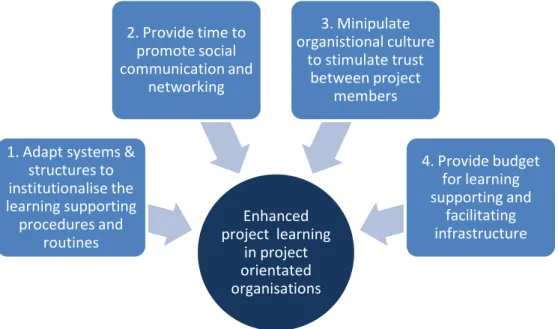
Limitations and Recommendations for Future Research
It also confirms that a lack of enabling environmental factors, such as learning-supporting infrastructure, inhibits learning in project organizations. Although knowledge and understanding of the various barriers and facilitators of project learning (or knowledge transfer in general) is growing and an awareness of these learning barriers is spreading, there still seems to be a significant lack of positive outcomes. In conclusion, this study advances our understanding of the potential impact of supporting infrastructure, institutionalized routines, social communication, and trust in a project environment on knowledge sharing and learning behaviors.
The findings are useful for organizations and specifically project management practitioners, for developing strategies to promote project learning and related competitive advantages. An investigation of the nature and type of "organizational learning infrastructure" supporting inter-project learning in Swedish consulting firms. Directions for future research in project management: The main findings of a UK government-funded research network.
